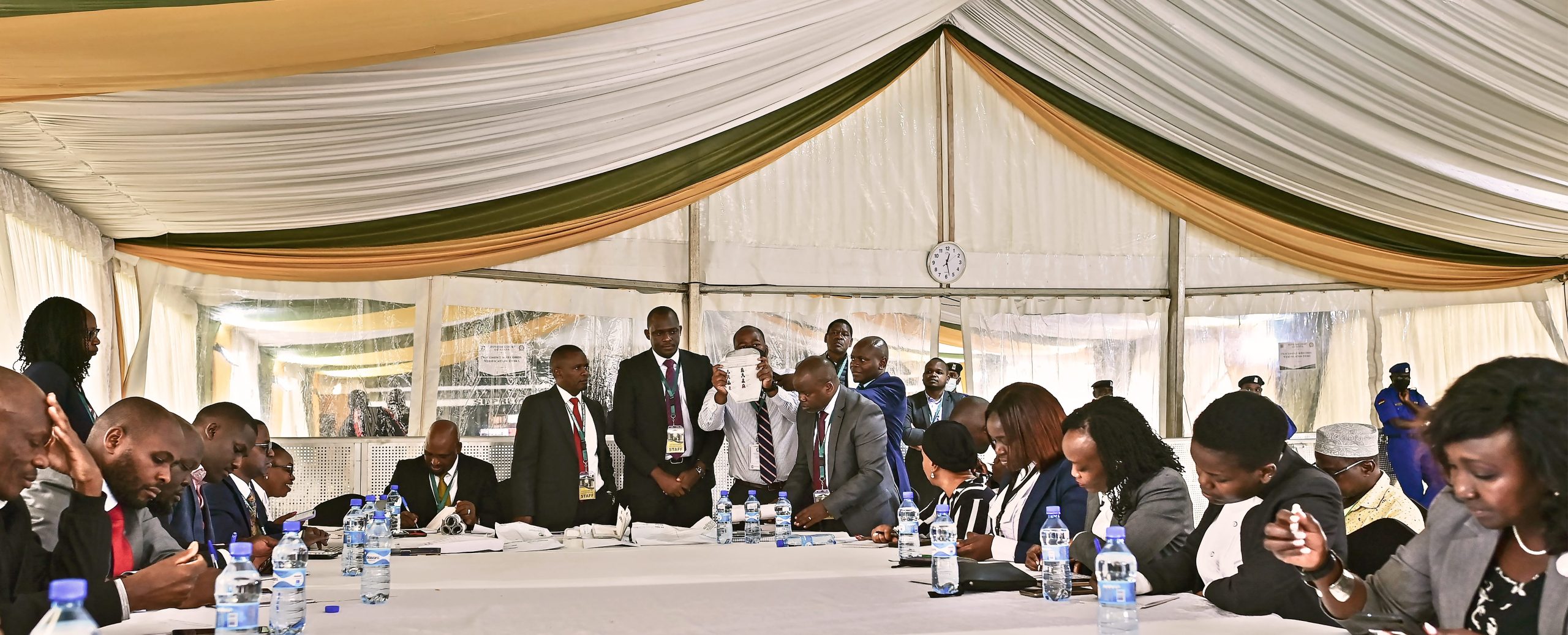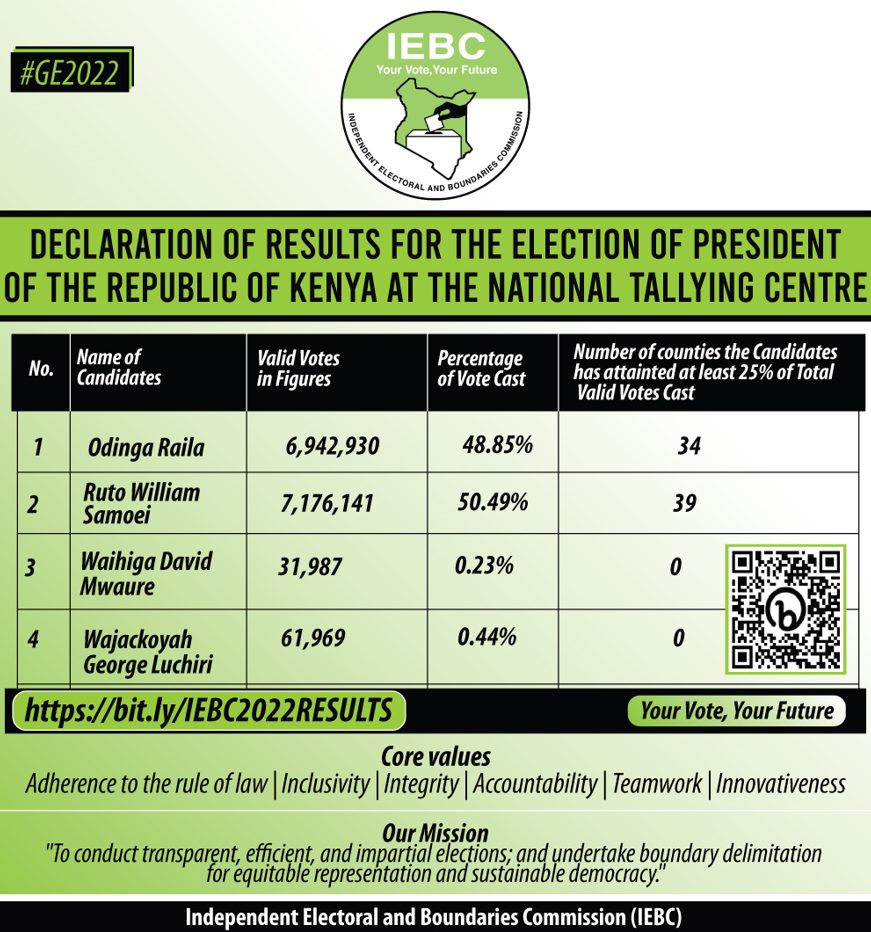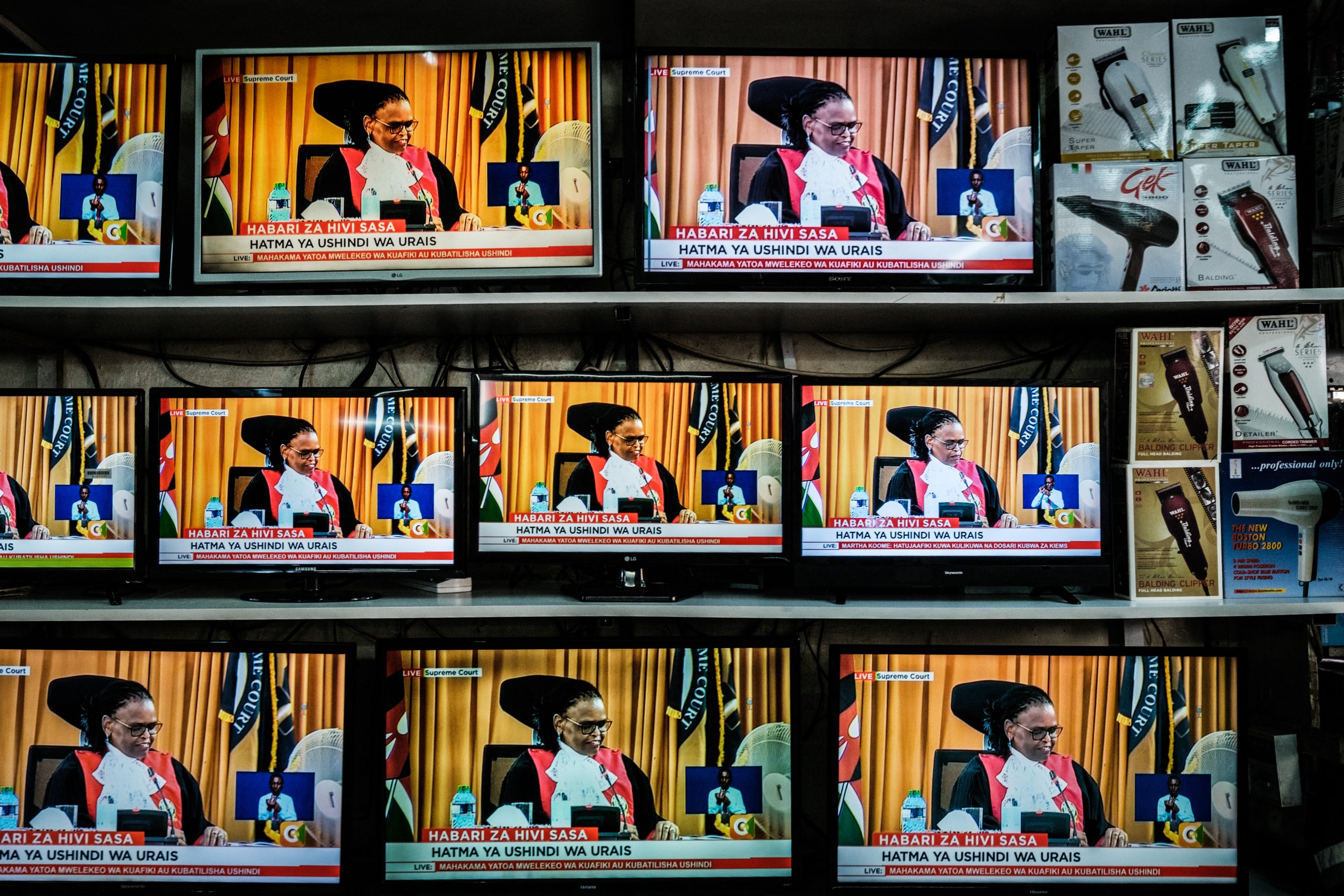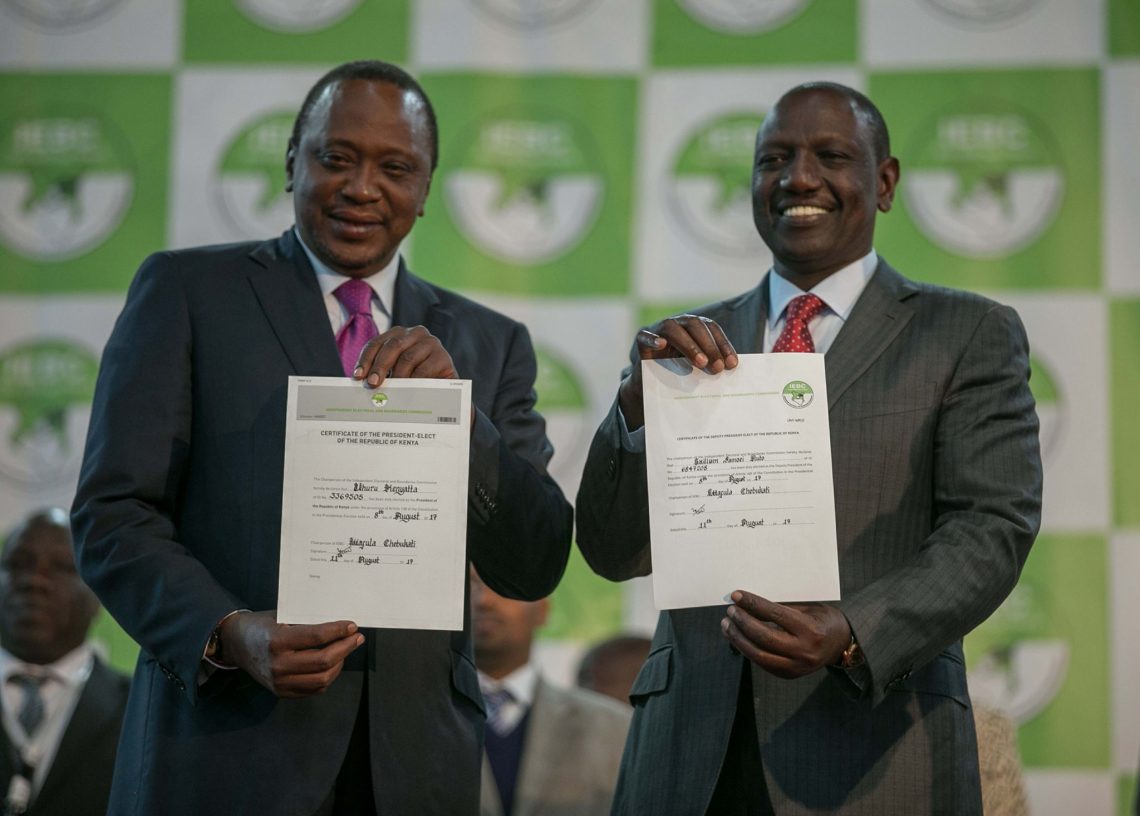English |Français

Presidential ballot forms are verified and counted by Supreme Court officials in the presence of legal officers and party agents after they were delivered by officials from the Independent Electoral and Boundaries Commission (IEBC) to the Supreme Court of Kenya. (Photo: AFP)
Kenya’s Supreme Court has upheld the results of the August 2022 presidential election affirming that Deputy President William Samoei Arap Ruto will be Kenya’s fifth president. Ruto garnered 50.5 percent of the vote versus Raila Odinga’s 48.9 percent—a difference of 233,000 votes out of more than 14 million cast.
Most distinctively, the electoral process was conducted in a markedly more transparent, competitive, and democratic climate than any previous Kenyan election. Understanding the factors that contributed to this higher standard, therefore, is vital to normalizing these measures—in Kenya and elsewhere in Africa.
Key Takeaways
1. Independent Monitoring Enhances the Legitimacy of the Outcome
The results validated by the Supreme Court were widely accepted, in part, because they were corroborated by the Nairobi-based Elections Observation Group (ELOG), Kenya’s largest election monitoring coalition. Its parallel vote tabulation (PVT) produced almost similar results to that of the Independent Electoral and Boundaries Commission (IEBC) with a margin of error of between 0.1 and 2.1 percent. ELOG deployed 5,000 observers in all 47 counties, covering 47,000 polling stations. An additional 1,000 PVT monitors crunched incoming data from the IEBC portal in real time.
Complementing the PVT, for the first time in Kenya—and possibly Africa—IEBC data released from the polling stations was accessible to the public. This allowed Kenyan media to run their own tallies and release provisional results 72 hours before the IEBC. Armed with this data, they also provided 24-hour analysis of the polls, setting a new norm worth emulating. The steady stream of data allowed the political parties, civil society organizations, and ordinary citizens to concurrently track the unfolding results. In other words, the public was kept informed of the seesaw nature of the contest and the factors that were shaping the outcome—facilitating its credibility.

Publicly available election results shared by Kenya’s IEBC. (Photo: IEBC)
2. Candidates Set Tone by Disavowing Violence
To their credit and despite the tight race, both leading candidates showed restraint from invoking their supporters to violence during the electoral process. Raila Odinga, in particular, demonstrated leadership and a commitment to the democratic process when, in the days after the election results were announced by the IEBC and his supporters were ready to take matters into their own hands, he said he would take his case to the courts. Rather than opting for violence to enhance his leverage or distract from the electoral math, he told his partisans to go home while he worked through the judicial system. Odinga invoked the same principle by accepting the court’s unanimous verdict, even though he disagreed with it. This courageous leadership must not be taken for granted. Kenyans of all political persuasions should honor this act of public service where the interests of the nation are put ahead of those of the individual. It is a standard to be upheld in future elections.
“Rather than opting for violence to enhance his leverage or distract from the electoral math, Odinga told his partisans to go home while he worked through the judicial system”
Similar acts of political magnanimity were observed down the ticket. Concession speeches by those who lost gubernatorial or local races, similarly, came in early and often. This created what Kenyan political commentator Patrick Gathara called “an un-Kenyan election,” a sharp contrast with previous elections that were filled with glaring malpractices.
3. The Courts Can Be a Force for Stability
“Beginning with the adoption of a new constitution in 2010, Kenya has slowly and purposefully been reinventing itself and its democracy,” says Patrick Gathara. He contends it also demonstrated a high degree of democratic maturity as Kenyans opted to litigate their differences over the election, rather than resort to force.
Much of this heightened trust in the courts can be traced to the 2010 Constitution which strengthened the independence of Kenya’s judiciary and other oversight institutions. Odinga’s decision to pursue legal channels to address his grievances was motivated, in part, by a renewed sense of confidence in the judicial system. For courts to play a similarly stabilizing role across Africa, this judicial trust must be earned, however.
A pivotal step in this evolution of judicial independence was the historic Maina Kiai Petition of 2016, a civil society-led petition introduced ahead of the 2017 election by legal scholar Maina Kiai. In agreeing with it, the High Court issued a ruling that overhauled Kenya’s electoral laws by introducing groundbreaking standards of transparency, ownership, integrity, and accountability—the outcomes of which were visible in the recently concluded polls.

Martha Koome, Chief Justice and President of the Supreme Court, is seen during a live broadcast on displayed TVs at an electronic shop in Nairobi. (Photo: AFP)
Among other changes, the Court ruled that election results at each polling station are final and cannot be altered in any way. This overturned the practice of vesting sweeping powers in the IEBC Chair to alone “confirm, alter, vary, and/or verify the presidential election results.” The Kiai Petition was upheld in its entirely in August 2017 by the Court of Appeals, Kenya’s highest court, rejecting a government appeal. The Supreme Court decision to overturn the 2017 elections was based on this petition.
While doubts over the autonomy of Kenya’s judiciary persist, with many Kenyans saying at least some of the country’s judges are corrupt, Kenya’s upper courts have painstakingly established institutional traditions of independence irrespective of their composition. Supporters cite the March 2022 landmark Supreme Court ruling that declared the controversial Building Bridges Initiative (BBI) illegal and promptly stopped the government-backed referendum that would have endorsed it. This initiative would have brought back the “imperial presidency” model of the Daniel Arap Moi era, which the 2010 Constitution abolished.
Another benefit from the enhanced transparency of the electoral process is that the Supreme Court will continue to be under heightened scrutiny in future elections. Since the public had access to all the IEBC polling data, citizens are in a better position to assess the court’s performance than they have been in the past.
4. The Need to Further Technocratize the IEBC
The election was not problem-free, to be sure. In their petition, Odinga’s Azimio La Umoja party alleged that the IEBC bungled the verification of results from the polling stations, especially during the final stages of tallying. Four of the seven IEBC commissioners, including Deputy Chair Juliana Cherera, disowned the results moments before they were released on August 15 by IEBC Chair Wafula Chebukati. The dissenting IEBC commissioners say they were excluded from verifying and aggregating results. According to Cherera, “We [IEBC] have improved our processes … we upped the bar but there was opaqueness in the last phase.”
This points to a key area for further reform. Leading jurists are now debating how the problems that beset the final phase of the election might be addressed. One recommended fix is to expand the provisions of the Maini Kiai Petition. Kiai observes that his eponymous petition can be improved by empowering the polling stations to announce their results after capturing them on the hardcopy Form 34 A, the primary record of Kenya’s polls. “With hindsight, there is still room for manipulation because anything can happen during the electronic transmission of Form 34 A to Nairobi for verification. Think of it, why should the final results be verified away from their source? It leaves room for the kind of disputes we saw within the IEBC itself.”
Kiai adds that manual entry of results at the polling station need not be electronically transmitted for “verification” in Nairobi. “We have learned with hindsight that electronic transmission can be manipulated even in more perfect settings. We are looking at a few external precedents that can be written into our electoral laws such as the Netherlands which reverted to manual entries across the board” to safeguard against potential foreign interference.
“Enhancing the technocratic dimensions and strictures on the IEBC may also lead to a more secure environment for election workers”
Enhancing the technocratic dimensions and strictures on the IEBC may also lead to a more secure environment for election workers. Chairman Chebukati lamented that his senior staff and commissioners had faced intimidation, threats, arbitrary arrests, and enforced disappearances during the tallying. A chilling illustration of this was the murder of senior IEBC officer, Daniel Mbolu Musyoka. He was abducted from a tallying center in the battleground of Embakasi on August 11 as he prepared to announce results. Two days later his body was found dumped near a forest with signs of torture and strangulation. Deputy Chair Cherera, similarly, has alleged multiple threats against her.
Kenya’s security services are facing pressure to investigate these and other serious complaints—a stark reminder of the still unfinished work Kenyans face to consolidate their hard-earned democratic gains.
5. Ethnicity Need Not Define Voter Motivations
Contrary to widely held expectations, Kenya’s largest and most economically influential community, the Kikuyu, voted overwhelmingly for William Ruto, a Kalenjin, handing him a victory in his rivalry with Uhuru Kenyatta, his former close ally of over 20 years. This is significant given the fresh memories of the infamous 2007 polls, when elite rivalries among both communities and the Luo, from which Odinga hails, exploded into bursts of violence that brought Kenya to the brink of civil war.
In turning up for Ruto this time around, Central Kenyans also effectively repudiated the powerful Kikuyu Council of Elders—the region’s unofficial but powerful kingmakers—who told their followers to vote according to wishes of the Kenyatta family. Notably, Ruto secured landslides in the home constituencies of President Kenyatta and Odinga’s running mate, Martha Karua—one of Central Kenya’s most formidable politicians. According to Kenyan political scientist Macharia Munene, “people are turning away from that [ethnicity], saying they are no longer going to be taken for granted.”
To illustrate this, both Ruto and Odinga ate aggressively into their respective strongholds, pockets of which became fiercely contested battlegrounds—far from the “safe zones” they had been assumed to be. Simply put, the old politics of undisputed ethnic kingpins and dominant political families seems to have lost resonance among Kenyan voters.
6. Incumbent Presidents Do Not Always Secure Their Preferred Successor
Raila Odinga’s loss has been widely interpreted as a major humiliation for President Kenyatta. Kenyatta had thrown his weight behind Odinga following their “handshake” in 2018 that put their enmity aside and further isolated William Ruto. Some say that the voting patterns were an attempt by voters to hold Kenyatta and Odinga accountable for trying to institute BBI, an initiative that proved to be hugely unpopular.

Kenyatta and Ruto in 2017. (Photo: Justice Hub)
Others say the Odinga brand was invariably damaged as the Ruto ticket pushed a narrative that the veteran opposition leader was merely Kenyatta’s “project.” This harkened back to the equally consequential election of 2002 in which a younger Kenyatta, then President Daniel Arap Moi’s hand-picked successor, garnered only 31 percent of the vote in what turned out to be a massive opposition landslide against the regime. His portrayal as “Moi’s project,” proved to be a major liability as even his own constituency channeled its votes to the opposition.
Kenya’s increasingly unpredictable and competitive elections buck the general trend in the region where predetermined electoral outcomes and poll-fixing are the often norm.
7. Sustained Civic Engagement on Institutional Reforms Can Have a Strategic Impact
Ruling parties in much of Africa often go to great lengths to keep electoral commissions on a tight leash to maintain themselves in office. In Kenya, the ongoing shifts toward more credible elections were rooted in sustained public interest litigation aimed at breathing new life into the IEBC and bringing electoral laws in line with constitutional requirements.
The tenacity and forward-thinking by civil society and professional groups—particularly the Law Society of Kenya—was key to all this, as shown by the history of ground-breaking constitutional petitions dating back to the 2017 elections. This, in turn, benefited greatly from a judicial branch that has demonstrated an increasing willingness to assert its independence and rule in the public interest. Collectively, these advancements underscore the value of institutional reform, as painstaking as the process may be.
Roadmap for Reform
“Kenyans have carved out a roadmap for themselves and democratic reformers across the continent.”
Kenya’s 2022 general election has not followed the familiar script of voters exercising their civic duty only to helplessly sit back and watch their votes be manipulated. Kenyans have attempted to correct this through comprehensive constitutional reforms, an active and vigilant citizenry, and an increasingly independent judiciary. In the process, Kenyans have carved out a roadmap for themselves and democratic reformers across the continent to follow to enhance the integrity and legitimacy of their electoral processes.
Additional Resources
- Africa Center for Strategic Studies, “Kenyan Elections—Another Test in the Country’s Democratic Journey,” Spotlight, July 11, 2022.
- Charles A. Ray, “Kenya’s Elections Will Come Down to the Wire,” Analysis, Foreign Policy Research Institute, June 28, 2022.
- International Crisis Group, “Kenya’s 2022 Election: High Stakes,” Briefing No 182, June 9, 2022.
- Catherine Lena Kelly, “Justice and the Rule of Law Key to African Security,” Spotlight, Africa Center for Strategic Studies, May 25, 2021.
- Africa Center for Strategic Studies, “Three Takeaways from the Kenya Supreme Court Ruling,” Spotlight, September 1, 2017.
- Godfrey Musila, “Legal Reforms Aim to Prevent Electoral Violence in Kenya,” Spotlight, Africa Center for Strategic Studies, July 26, 2017.
More On: Democracy

